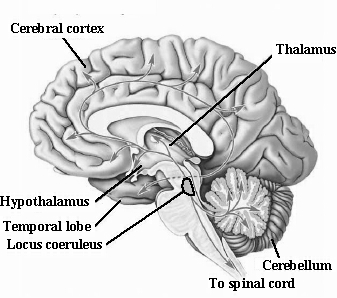A small, bluish region on either side of the pons in the brain stem that lies near the lateral wall of the fourth ventricle. It consists of some 20,000 melanin-pigmented cell bodies (hence it is also referred to as the pigmentosus pontis), and contains the generally excitatory catecholamine neurotransmitter norepinephrine (or noradrenaline). Consequently, it is considered to an important brain center for anxiety and fear, as well as for the maintenance of arousal and vigilance more generally. Another of its functions appears to be its involvement in the initiation of REM sleep following a bout of slow-wave sleep. While the specific terminations of its neurons have not been clearly identified, their axons have a widespread distribution in the cerebral cortex, the cerebellum, the hypothalamus, and the spinal cord (see figure below).
